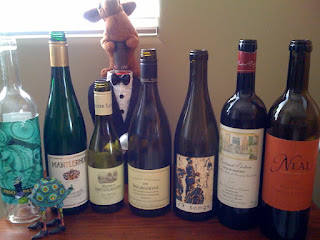
“How did three people go through so many glasses?!!!”, said Kara as she walked into the kitchen. You’d think she’d be used to it by now. Four courses paired to wine with some educational tasting in between… Sure, why not?
One of my co-workers, Josh, and his roommate Phillip came over the other night. Josh and Phillip are wine novices, but with a strong interest in learning more. I quickly put on my cape with the big “S” (that stands for “Sommelier”, of course) and threw together a spontaneous meal to show off some interesting wines they might not have seen before.
When they arrived, I poured the Paso a Paso Verdejo. This is a cool little Spanish white that is pretty readily available on the market. I often equate it to a flatter version of Sauvignon Blanc, smelling a bit like green bell pepper seeds and taking the grapefruit/citrus down a couple of notches. I often like this with Prosciutto and mild cheeses, but tonight we just rocked it out as an aperitif while I took care of last looks in the kitchen.

First course was a simple shrimp cocktail served classically on crushed ice with a ramekin of cocktail sauce center stage. I paired up a Mantlerhof Gruner Veltliner 2007. Niether of these guys had ever had a Gruner before! This particular bottling leans a little more toward the off-dry set, but with the typical acidity of Gruner, it just comes off feeling really round and plush. Great balance and less of the radish/asparagus focus than most Gruners. Burnt orange rind, yellow peach, a little smoke. It’s good stuff!
Since it was their first time with Gruner and they were loving it, I had to give them a compare/contrast. I opened a half bottle of Brundlmayer’s Berg Vogelsang Gruner 2008, just to show them a more classic style of Gruner Veltliner. This pushed much more of the mineral quality and was certainly much drier. The peach was more of a white peach, with underripe lemon, white pepper and chalk. I preferred the Brundlmayer, myself. But it was a more austere vintage which I tend to like.
For our second course, I paired a simple Girardin white Bourgogne 2006 with my homemade Lump Crab Cakes and Mustard Mayonnaise Sauce. I really love this little Burgundy. And it’s CHEAP! Apple and pear flavors that are ripe and round, with just enough acidity to keep it lively. It’s a crowd-pleaser. We’ve been pouring it at Jar for awhile now as our “entry-level” Chard and I’ve never had a complaint – even though it isn’t from California, which seems to be sacrilege in Los Angeles.
Moving on to the main course, we had New Yorks with some freshly Sauteed Corn and Sauteed Cremini Mushrooms. I gave them a three-pronged pairing for this extravaganza. First, the 29 Songs Syrah 2005: a 100% Syrah from cool-climate Napa. They only make just shy of 300 cases. It’s so much like Northern Rhone Syrah! Meaty, peppery and roasted herbs all over the nose. The palate is pure blueberry (but not jam), raspberry and blackberry. It was my favorite wine of the flight.
The second wine was some leftover Bertaud-Belieu Cote de Provence 1999. This has been open a little too long and wasn’t holding up due to the bottle age. I just smelled it and had to dump it. It’s a 50% Syrah and 50% Cabernet Sauvignon blend. Normally, it would’ve been showing well. Doomed for my next sauce now.
The third wine was the 2002 Neal Family Napa Cabernet Sauvignon. This is 100% Cabernet blended from Mark’s vineyards across the valley. 2002 was one of my favorite vintages for a long while. Just plush and generous on the fruit. This wine was no exception. Loads of cassis, black currant, a hint of cola and showing signs of age with anise and dried baking spices. This is my favorite Cab they’ve ever made, including the higher end single vineyard wines. It’s drinking beautifully with some time left in it.
With the Butterscotch Pudding for dessert, I just poured them a few interesting things. A 2004 Sauternes, a Chamomille Grappa from Marolo, and a small shot of Fernet Branca. The Grappa is one of my favorite pairings with the pudding. It totally brings out this spiciness and cuts the residual sugar in the Grappa. If you’re in the area, you’ve got to get to Jar to check out this combination!

(I think Josh may have been a little loopy by the time I got this photo...)
I spent the morning after washing stemware. It was worth it though. I think the guys learned about a couple of new wines and certainly had the chance to differentiate between some things by doing a side-by-side. That’s usually the big part of learning wine is getting things together to compare them. God willing, Josh will be able to make an educated guess whether a wine is a Syrah or a Cab now. If not, that terrible hangover will have all been for nothing!
Until next time…











